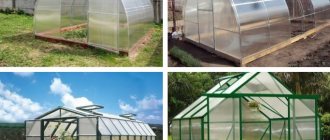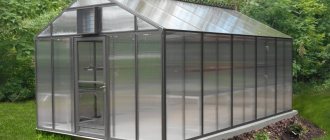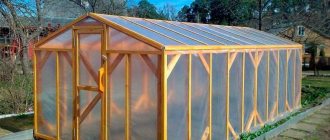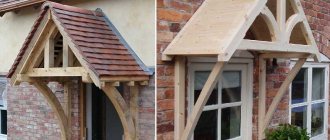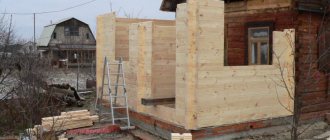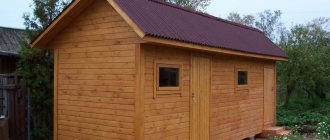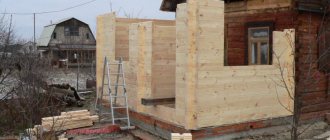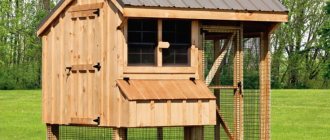Every novice gardener has to face the question of how to make a greenhouse on their own plot. This design allows you to easily start growing natural, fresh vegetables and herbs in early spring, even at sub-zero night temperatures. In addition, the greenhouse is able to protect delicate plants from heavy precipitation, wind and direct sunlight.
If you choose the right building material and optimal design, you can get an indispensable garden assistant.
Pros of using polycarbonate
Unlike glass greenhouses, polycarbonate has more advantages, such as:
Compared to glass, polycarbonate is much stronger. For example, snow in winter can cause glass to crack or even break, while polycarbonate is more resistant to bad weather.
It transmits less ultraviolet rays, which means that the plants you grow in a polycarbonate greenhouse will be burned less than in a classic glass one.
Excellent thermal insulation, compared, again, with glass, it retains heat better, since the polycarbonate material is two-layer.
Withstands temperature changes and maximum altitudes well. Glass may crack.
When heated, the material is flexible, making it quite easy to work with and drills well. Polycarbonate is produced in separate sheets of standard sizes, due to which you can cover the greenhouse with 3-4 sheets.
Compared to a glass greenhouse, a polycarbonate greenhouse diffuses the sun's rays, thereby preventing your plants from getting burned.
Well, the last, important plus is the price. A greenhouse made of polycarbonate will cost much less than one made of glass.
Design features
A greenhouse made into reality, made with one’s own hands, occupies an important place on a summer resident’s plot. A greenhouse made by yourself does not mean that it will be less effective in its functionality.
Photos and drawings of greenhouses for making with your own hands can be viewed and studied on thematic websites. The design of the greenhouse and its shape will depend on the purpose of the object.
The most popular materials for the construction of greenhouses are fiberglass or galvanized metal profile pipes, which serve as a load-bearing role for the structure. Glass, polyethylene film, polycarbonate can be used as a coating.
Cons of polycarbonate
But when choosing polycarbonate, do not forget about the disadvantages of this material:
Polycarbonate is not durable. Constant exposure to sunlight makes the greenhouse more fragile.
There are a lot of fakes, if you are unlucky and you purchased low-quality polycarbonate, then you may be in big trouble due to its insufficient strength. A standard good quality polycarbonate sheet will weigh 10kg, if yours weighs less it could be a fake.
There may be problems with additional heating of the greenhouse. Avid summer residents, in order to extend the harvest year, install additional heating in them.
- Lawn laying
A garage at the dacha is not a warehouse, but a modern and comfortable space!
Diesel generator for home: which one to choose?
Flaws
In addition to the strengths, there are also weaknesses. First of all, this is the flammability of the material. When exposed to an open source of fire or hot objects, it begins to melt, losing its previous shape.
Polycarbonate is also relatively expensive compared to other materials. However, there is a wide range of this material on sale in different price categories, which allows each summer resident to choose the most suitable option for himself.
Foundation for a greenhouse
A polycarbonate greenhouse must be installed on a rigid base. So, what could be the foundation for a polycarbonate greenhouse:
The beam, it is worth noting that it is not advisable to lay it on the ground, it will not last long. Such a foundation can be fixed on piles or on brick foundations.
The brick is laid on a cement strip base. Such a foundation is durable, but again, only if it is laid out correctly.
Role in landscape design
When building a structure for growing crops, it is important to take care of its organic integration into the overall picture of the site. The greenhouse should become a full-fledged element of landscape design. Individual design will allow you to create a real masterpiece. There is room for all ideas and creativity. The frame of the structure can be openwork or made in an unusual style, repeating the architecture of the house and other structures. An unusual combination of the materials used, creative lighting and decoration of the greenhouse will allow it to become a real pearl of the garden. With sufficient financial resources, you can build a transforming greenhouse. From early spring to early summer, the structure will serve for planting and growing vegetables and flowers. And in summer it becomes a gazebo or recreation area.
Fitting an ordinary annual greenhouse into an existing style concept of a site is not so easy. Considering that the greenhouse should be located in a well-lit and visible area. Without being particularly aesthetically pleasing in appearance, it can disrupt the entire harmony of the garden. It is better to place it in a specially designated working area of the site, which will be separated by a hedge or other element of small architecture from prying eyes. The structure should not be larger than average in size, otherwise it will begin to cast a shadow that can block the greenhouse’s access to sunlight.
Buying a polycarbonate greenhouse
You have finally decided on buying a greenhouse, then after reviewing a large number of photos of polycarbonate greenhouses, and choosing one, use some tips before purchasing:
Study the manufacturer carefully; even in products such as greenhouses, fakes are often found. It is better to buy not through an intermediary, but directly from the manufacturer.
If you buy a greenhouse through an online store, then check all the characteristics so that the structure does not arrive too fragile and you will not suffer large losses later. When receiving the greenhouse, check the packer's stamp with the date and shift number.
Please note that you are buying a completed structure, you do not have to finish it, if suddenly during assembly you were missing any holes or fasteners, keep in mind. You purchased a fake. If you have already drilled or fixed something in it, your chances of returning the item are minimal.
Consider the climate in which you live, how much the frame and the coating itself will be loaded. If your climate does not have a lot of snow, then you can buy a more economical greenhouse, in which the thickness of the carbonate will be less than standard.
Check the polycarbonate itself; if the ribs are pressed through, it means the product is of poor quality.
Please note that managers may take the economy version greenhouse as the basic design, which means the thickness of the polycarbonate will be thin and the frame will not be strong enough. Before purchasing, check the thickness of the coating and the material of the frame and, of course, the total amount.
Please note that when purchasing a stationary greenhouse with economical thickness polycarbonate, you will have to change the covering after 9 years.
Choosing a polycarbonate greenhouse is far from being as simple as it seemed at the very beginning. The same goes for building a greenhouse with your own hands, you need to carefully study the purchased material.
The best greenhouse for year-round use is one with a frame made of polypropylene pipes reinforced with timber. Construction with your own hands is not expensive, and the result will bring you great pleasure!
Briefly about the main thing
The first greenhouse buildings, which appeared at the end of the 16th century, a hundred years later spread throughout Europe and became a familiar feature of the rural landscape. The English greenhouse is a special type of structure. It is distinguished from the usual greenhouses by its design features: a characteristic roof, high walls, original glazing, the presence of a vestibule and additional greenhouses on the sides.
Traditional Chelsea greenhouses were made of wood and glass. For modern summer (seasonal) options, a post-transom system is used. For a year-round greenhouse, an aluminum profile and double-glazed windows are suitable. All buildings look elegant thanks to their elongated shape, lancet windows and high foundation with a plinth.
Ratings 0
How to assemble a greenhouse-breadbox
As a rule, the procedure for creating this type of greenhouse is as follows:
- First of all, you need to prepare the design details: use a pipe bender to make half-arcs; in this case, two half-arcs must be smaller in size, and the other two must be larger.
- Next, the side parts are welded with horizontal jumpers
- The next step is to weld the frame of the required dimensions and increase the frame to the required height
- After the bed is ready, you should begin installing the greenhouse and fastening it with wooden or metal pins stuck into the ground to a depth of at least 50 cm.
- Next, all the elements are sheathed with polycarbonate using self-tapping screws, and then on each side of the base, the half-arc sidewalls are connected using a hinge method.
This design can last forever, sometimes changing the polycarbonate sheets and treating the hinge structures with an oily substance.
All greenhouse projects have their advantages and disadvantages, however, it is necessary to take into account the size, cost, and duration of use of the greenhouse.

